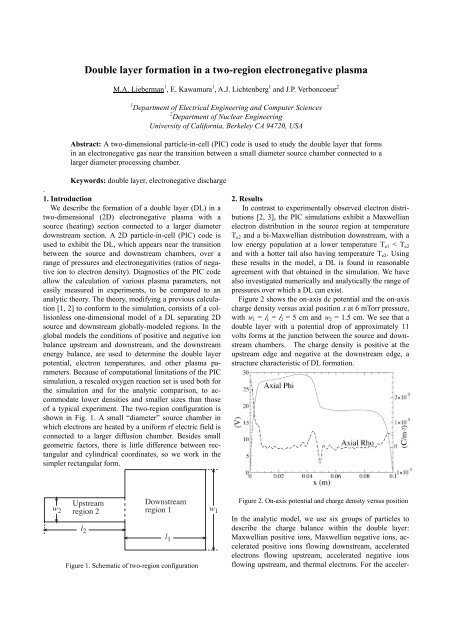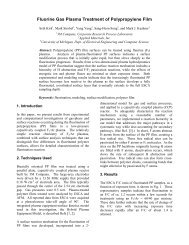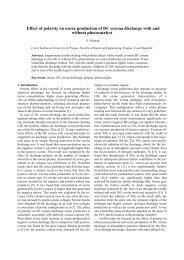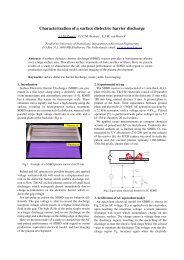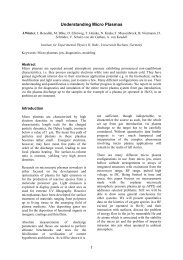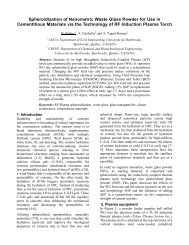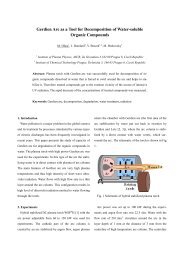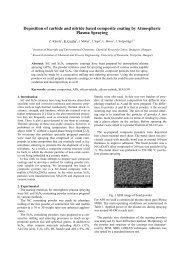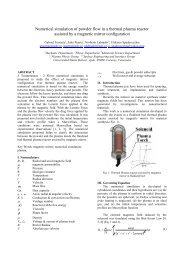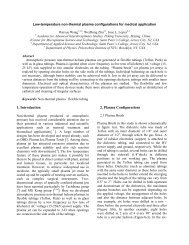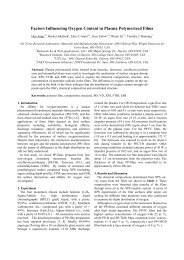Double layer formation in a two-region electronegative plasma
Double layer formation in a two-region electronegative plasma
Double layer formation in a two-region electronegative plasma
Create successful ePaper yourself
Turn your PDF publications into a flip-book with our unique Google optimized e-Paper software.
<strong>Double</strong> <strong>layer</strong> <strong>formation</strong> <strong>in</strong> a <strong>two</strong>-<strong>region</strong> <strong>electronegative</strong> <strong>plasma</strong>M.A. Lieberman 1 , E. Kawamura 1 , A.J. Lichtenberg 1 and J.P. Verboncoeur 21 Department of Electrical Eng<strong>in</strong>eer<strong>in</strong>g and Computer Sciences2 Department of Nuclear Eng<strong>in</strong>eer<strong>in</strong>gUniversity of California, Berkeley CA 94720, USAAbstract: A <strong>two</strong>-dimensional particle-<strong>in</strong>-cell (PIC) code is used to study the double <strong>layer</strong> that forms<strong>in</strong> an <strong>electronegative</strong> gas near the transition between a small diameter source chamber connected to alarger diameter process<strong>in</strong>g chamber.Keywords: double <strong>layer</strong>, <strong>electronegative</strong> discharge.1. IntroductionWe describe the <strong>formation</strong> of a double <strong>layer</strong> (DL) <strong>in</strong> a<strong>two</strong>-dimensional (2D) <strong>electronegative</strong> <strong>plasma</strong> with asource (heat<strong>in</strong>g) section connected to a larger diameterdownstream section. A 2D particle-<strong>in</strong>-cell (PIC) code isused to exhibit the DL, which appears near the transitionbetween the source and downstream chambers, over arange of pressures and electronegativities (ratios of negativeion to electron density). Diagnostics of the PIC codeallow the calculation of various <strong>plasma</strong> parameters, noteasily measured <strong>in</strong> experiments, to be compared to ananalytic theory. The theory, modify<strong>in</strong>g a previous calculation[1, 2] to conform to the simulation, consists of a collisionlessone-dimensional model of a DL separat<strong>in</strong>g 2Dsource and downstream globally-modeled <strong>region</strong>s. In theglobal models the conditions of positive and negative ionbalance upstream and downstream, and the downstreamenergy balance, are used to determ<strong>in</strong>e the double <strong>layer</strong>potential, electron temperatures, and other <strong>plasma</strong> parameters.Because of computational limitations of the PICsimulation, a rescaled oxygen reaction set is used both forthe simulation and for the analytic comparison, to accommodatelower densities and smaller sizes than thoseof a typical experiment. The <strong>two</strong>-<strong>region</strong> configuration isshown <strong>in</strong> Fig. 1. A small “diameter” source chamber <strong>in</strong>which electrons are heated by a uniform rf electric field isconnected to a larger diffusion chamber. Besides smallgeometric factors, there is little difference between rectangularand cyl<strong>in</strong>drical coord<strong>in</strong>ates, so we work <strong>in</strong> thesimpler rectangular form.2. ResultsIn contrast to experimentally observed electron distributions[2, 3], the PIC simulations exhibit a Maxwellianelectron distribution <strong>in</strong> the source <strong>region</strong> at temperatureT e2 and a bi-Maxwellian distribution downstream, with alow energy population at a lower temperature T e1 < T e2and with a hotter tail also hav<strong>in</strong>g temperature T e2 . Us<strong>in</strong>gthese results <strong>in</strong> the model, a DL is found <strong>in</strong> reasonableagreement with that obta<strong>in</strong>ed <strong>in</strong> the simulation. We havealso <strong>in</strong>vestigated numerically and analytically the range ofpressures over which a DL can exist.Figure 2 shows the on-axis dc potential and the on-axischarge density versus axial position x at 6 mTorr pressure,with w 1 = l 1 = l 2 = 5 cm and w 2 = 1.5 cm. We see that adouble <strong>layer</strong> with a potential drop of approximately 11volts forms at the junction between the source and downstreamchambers. The charge density is positive at theupstream edge and negative at the downstream edge, astructure characteristic of DL <strong>formation</strong>.In the analytic model, we use six groups of particles todescribe the charge balance with<strong>in</strong> the double <strong>layer</strong>:Maxwellian positive ions, Maxwellian negative ions, acceleratedpositive ions flow<strong>in</strong>g downstream, acceleratedelectrons flow<strong>in</strong>g upstream, accelerated negative ionsflow<strong>in</strong>g upstream, and thermal electrons. For the accelerw2UpstreamDownstream<strong>region</strong> 2<strong>region</strong> 1 w 1l 2l 1Figure 1. Schematic of <strong>two</strong>-<strong>region</strong> configurationFigure 2. On-axis potential and charge density versus position
Figure 3 shows the balances determ<strong>in</strong>ed from the PICsimulation (black bars) and the comparison to the double<strong>layer</strong> and global model calculation of the balances (whitebars), for a system at 6 mTorr that is twice as large as thesystem for which the data <strong>in</strong> Figure 2 is shown (w 1 = l 1 =l 2 = 10 cm and w 2 = 3 cm). For this system a 6.5 volt double<strong>layer</strong> is found to form. The larger size makes the PICdouble <strong>layer</strong> more one-dimensional, correspond<strong>in</strong>g moreclosely to the 1D model. There is a reasonable agreementbetween the 2D PIC simulations and the double <strong>layer</strong> andequilibrium global model calculations.2D PIC simulations have been made over a wide rangerange of pressures from 0.5 to 12 mTorr <strong>in</strong> the systemshown <strong>in</strong> Figure 1 with w 1 = l 1 = l 2 = 10 cm and w 2 = 3 cm.At 0.5 mTorr, the double <strong>layer</strong> does not appear to exist.At 1 and 1.5 mTorr a stable double <strong>layer</strong> is formed. At 2and 3 mTorr, a double <strong>layer</strong> is formed that co-exists withan unstable slow wave that orig<strong>in</strong>ates downstream at lowamplitude and propagates upstream <strong>in</strong>to the double <strong>layer</strong>as it grows. The wave frequency is 50–100 kHz and thewavelength is of order of 1 cm. This wave produces small(~20%) fluctuations <strong>in</strong> the double <strong>layer</strong> potential and <strong>in</strong>the position of the double <strong>layer</strong> with<strong>in</strong> the system. Webelieve this is the unstable slow wave downstream <strong>in</strong>stabilitypredicted and observed by Tuszewski and Gary [4].It is driven by the counter-stream<strong>in</strong>g flows of the positiveand negative ions <strong>in</strong> the downstream <strong>region</strong> near the double<strong>layer</strong>. At higher pressures of 4.5, 6, and 12 mTorr, adouble <strong>layer</strong> is formed that co-exists both with the unstableslow wave and with an additional fast wave hav<strong>in</strong>g awave frequency of order 1 MHz and a wavelength of orderof 1 cm. This fast wave also orig<strong>in</strong>ates <strong>in</strong> the downstream<strong>region</strong> and propagates upstream <strong>in</strong>to the double<strong>layer</strong> as it grows <strong>in</strong> amplitude, but its stability is uncerta<strong>in</strong>.suggest that a double <strong>layer</strong> hav<strong>in</strong>g a given ”strength”(double <strong>layer</strong> potential V s ) forms between the upstreamsource <strong>region</strong> and the downstream <strong>region</strong> <strong>in</strong> order that theequilibrium particle and energy balance relations with<strong>in</strong>the <strong>two</strong> <strong>region</strong>s can be satisfied. A global model of particleand energy balances for the <strong>two</strong> <strong>region</strong>s, as shown <strong>in</strong>Figure 3, has been found to capture the essential physicslead<strong>in</strong>g to double <strong>layer</strong> <strong>formation</strong> <strong>in</strong> this system.References[1] M.A. Lieberman, C. Charles, and R.W. Boswell, J.Phys. D 39, 3294 (2006).[2] P. Chabert, A.J. Lichtenberg, and M.A. Lieberman,Phys. Plasmas 14, 093502 (2007).[3] N. Plihon, P. Chabert, and C.S. Corr, Phys. Plasmas14, 013506 (2007).[4] M. Tuszewski and S.P. Gary, Phys. Plasmas 10, 539(2003).The smaller-dimensioned device resulted <strong>in</strong> results similarto those described above, at correspond<strong>in</strong>gly larger pressures,except that the wave activity was less evident.3. ConclusionsTwo-dimensional particle-<strong>in</strong>-cell simulations have beenfound to be powerful tools to study the physics of double<strong>layer</strong> <strong>formation</strong> <strong>in</strong> a <strong>two</strong>-dimensional <strong>electronegative</strong><strong>plasma</strong> formed <strong>in</strong> a source heat<strong>in</strong>g chamber that is connectedto a larger downstream chamber. The PIC simulationsallow non-perturb<strong>in</strong>g “measurements” to be madewith<strong>in</strong> the double <strong>layer</strong> itself, which would be very difficult,if not impossible, to do <strong>in</strong> a laboratory experiment.For example, <strong>in</strong> Figure 2 we determ<strong>in</strong>ed the charge densitywith<strong>in</strong> the double <strong>layer</strong> itself; this charge density, andits decomposition <strong>in</strong>to the three charged species (positiveions, negative ions and electrons) <strong>in</strong> the simulation, willallow us to make detailed comparisons with analyticmodels of double <strong>layer</strong> structure. The simulations also


